Day 2 of a four day Autumn Tour today. It was a more mixed day weather-wise, mostly dry apart from a brief squally shower this morning, but with a rather blustery SW wind all day, gusting up to 40mph at times. Still, it didn’t hold us back and we had another great day out.
After meeting in Wells, we headed west along the coast to Titchwell for the day. There were lots of geese in the stubble fields by the road – lots of Greylags with a good number of Pink-footed Geese and a few Egyptian Geese too.
At Titchwell, the main car park was slowly starting to fill up, so we went for a quick look round the overflow car park before it got too busy. There were several Blackbirds in the apple trees – possibly some of them were freshly arrived from the continent overnight – and a couple of Redwings were calling from the hedge as we walked past. We flushed several finches from the brambles, a few Chaffinches and a noisy flock of Greenfinches. A Brambling flew over calling, as did a single Grey Wagtail. Otherwise, there were not that many birds in here this morning, so we decided to head out onto the reserve. A Redwing flew across in front of us and perched briefly in the top of the trees, before diving into cover.
A Grey Phalarope (also confusingly called a Red Phalarope, for our North American tour participants!) had appeared at Titchwell yesterday, so after enjoying great views of the Red-necked Phalarope yesterday, we thought we would go to look for the Grey today. Before we got out of the car park, we received a message to say that it had just flown in closer and was now showing very well in front of Parrinder Hide, so we headed straight round there.
When we got out onto the main path, we could see some dark clouds heading our way, so we didn’t linger to scan for birds on the way out. A Bearded Tit was pinging from the reeds by the Thornham grazing marsh dry pool and zipped across the tops before diving back into cover. A single Eurasian Curlew was very well camouflaged standing in the vegetation out on the saltmarsh, whereas the Little Egret stood out like a sore thumb!
There were quite a few people in Parrinder Hide already, but we managed to find space for all of us. Just in time, as a squally shower passed over. Within a minute or so of us arriving, the Grey Phalarope appeared from behind the reeds. Unusually for a phalarope, it seemed to have realised it was a wader and was feeding along the edge of the water, walking around on the mud. Normally they prefer to swim! It picked its way steadily towards the hide and was soon only a few metres away from us – great views.
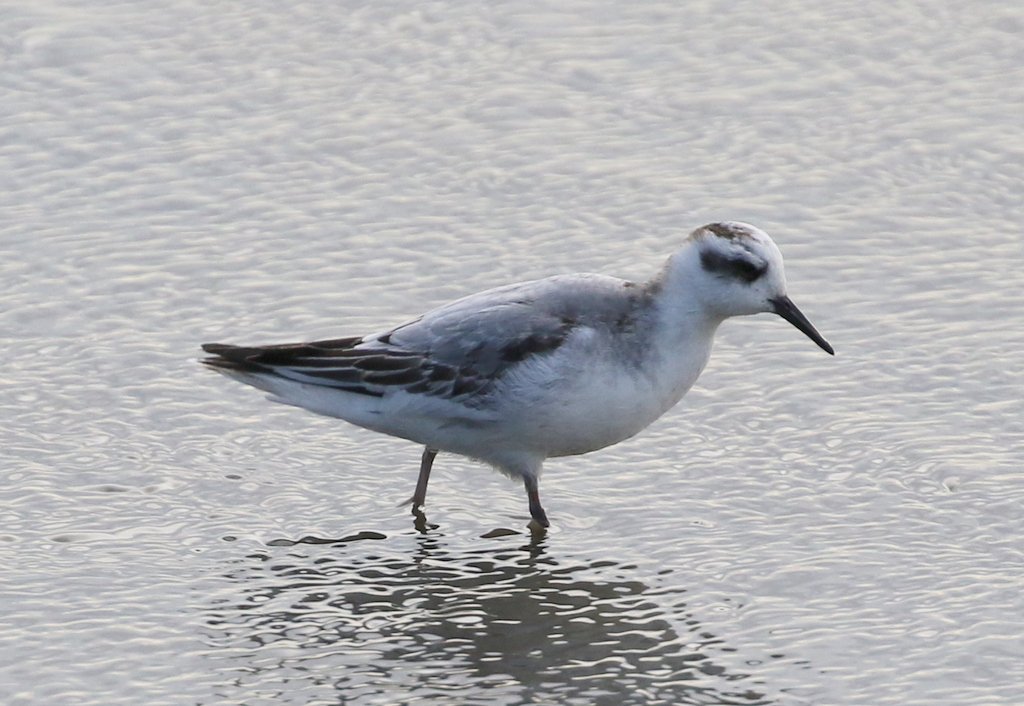 Grey Phalarope – mostly feeding like a wader rather than swimming today
Grey Phalarope – mostly feeding like a wader rather than swimming today
Up close like this, we could see the Grey Phalarope was a young bird, moulting into 1st winter plumage. It had already moulted its mantle and scapulars extensively, with new pale grey feathers, but still retained several white-fringed black juvenile feathers, particularly on its wings. It was also a little bit chunkier, with a slightly thicker, heavier bill than yesterday’s Red-necked Phalarope, which was still mostly in juvenile plumage.
The Grey Phalarope worked its way up and down on the mud, doing a little circuit, occasionally flying back out of sight behind the reeds, before making its way back out again along the muddy water’s edge. At one point it, when it got to the nearest point of the mud, it flew across and landed down right in front of the hide windows. From time to time, it would swim across the water, but it seemed to prefer to head back each time to the mud.
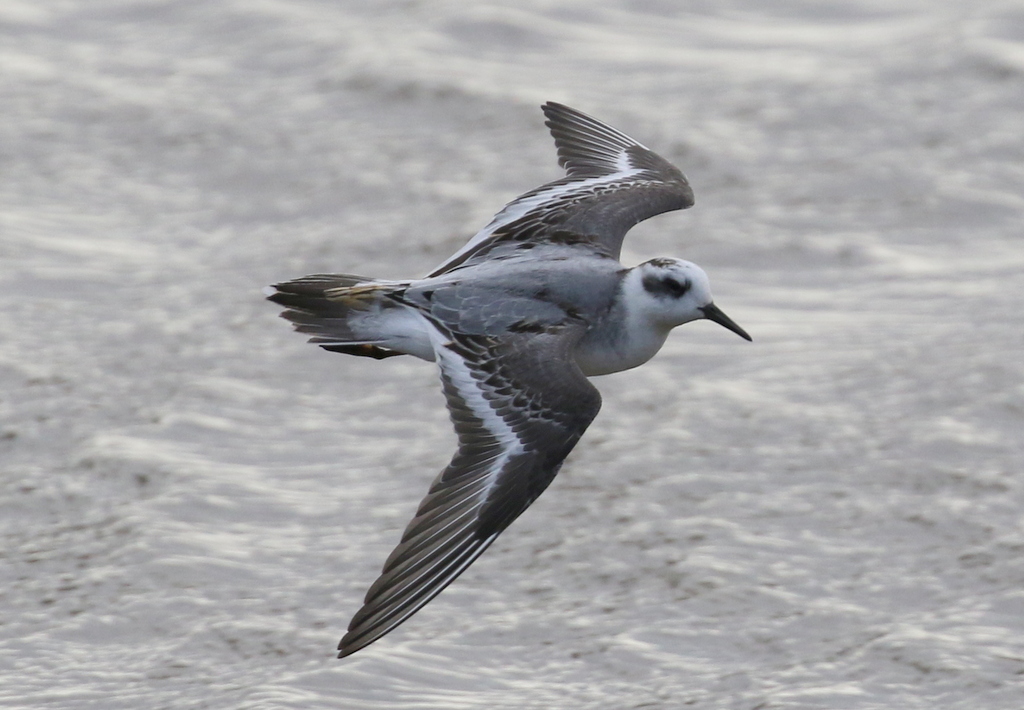 Grey Phalarope – flew right in front of Parrinder Hide
Grey Phalarope – flew right in front of Parrinder Hide
Whenever the Grey Phalarope disappeared from view behind the reeds, we turned our attention to the other birds out on the scrape. There was a nice selection of waders. A large flock of Bar-tailed Godwits were roosting out in the shallow water. Through the scope, we could see there was a mixture of paler adults and more richly coloured juveniles. As one preened, we could see its barred tail. Nearby, a big group of Black-tailed Godwits were feeding. We could see their much plainer, darker grey-brown upperparts.
There were several Ruff out on the freshmarsh too, a mixture of paler adults and browner juveniles. A small flock of Eurasian Golden Plover flew in and landed on one of the islands out in the middle, where they proceeded to bathe and preen before going to sleep.
There were several little groups of Dunlin around the scrape too. They were rather jumpy in the wind and mobile, flying around and feeding in different places, before getting spooked again. At first the two Little Stints were hard to find. They were not feeding with the Dunlin, but at first we located them on their own along the mud the other side, in front of the reeds. The Little Stints were skittish too, and flew round and across in front of us, before dropping down between the islands.
 Dunlin – this small flock flew round and landed in front of Parrinder Hide briefly
Dunlin – this small flock flew round and landed in front of Parrinder Hide briefly
There are plenty of ducks here now, with large numbers of Eurasian Teal and Eurasian Wigeon in particular having returned for the winter already. Most of the drakes are still in rather drab eclipse plumage, but some are starting to moult out already. A small group of Wigeon walked across to graze on the island opposite the hide, with a smart drake in amongst them. There were lots of Teal right in front of the windows, which gave us a great opportunity to look at the differences in moult progress between them. The drake Gadwall are mostly already back in breeding plumage.
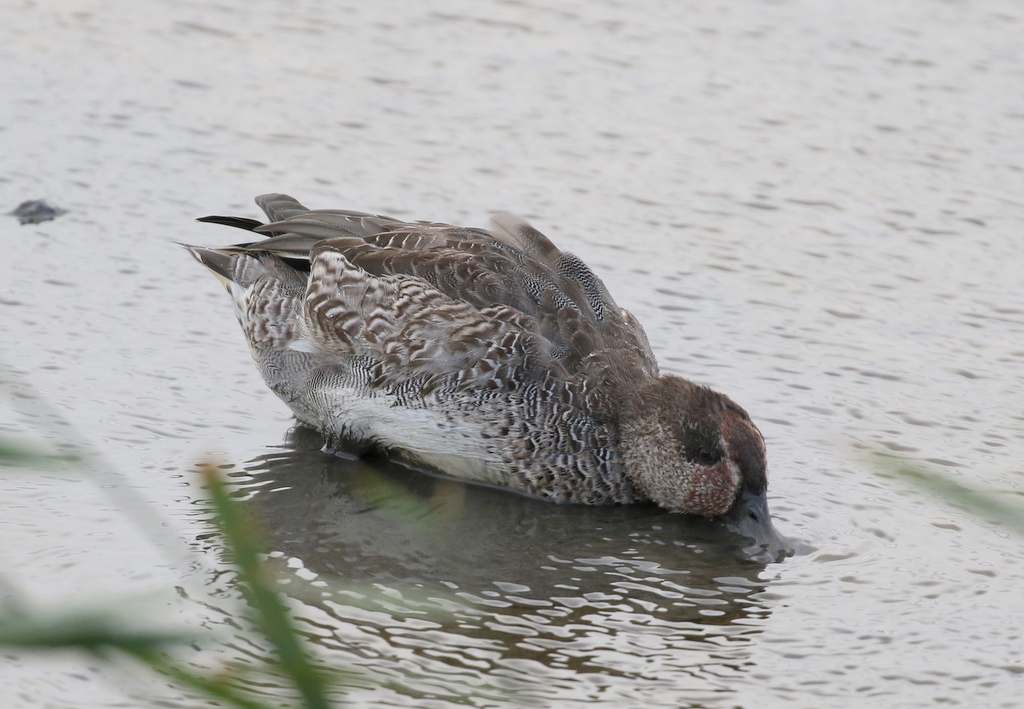 Eurasian Teal – this drake is just starting to moult out of eclipse plumage
Eurasian Teal – this drake is just starting to moult out of eclipse plumage
There were a few passerines on the freshmarsh too. Little flocks of Linnets kept fluttering about on the edge of the water. A couple of Pied Wagtails were feeding on the short grass on the islands and a Meadow Pipit or two appeared with them. A Skylark flew in and dropped down on the grass.
Eventually, with the weather improving, we decided to head out towards the beach. We popped into the other side of the Parrinder Hide, but the Volunteer Marsh from this side looked largely deserted, apart from several Redshanks. A female Eurasian Kestrel was perched on one of the fence posts along the edge of the bank. As we left the hide, the Kestrel flew off across the mud, flushing the Redshanks which called noisily and several Linnets which had been hiding in the vegetation.
 Eurasian Kestrel – perched on the fence posts on the edge of Volunteer Marsh
Eurasian Kestrel – perched on the fence posts on the edge of Volunteer Marsh
There were more waders on the far side of the Volunteer Marsh, in the tidal channel viewable from the main path. They were mostly Black-tailed Godwits and Redshanks, plus a couple of Curlew. But towards the back, occasionally hiding down in the muddy creeks, we found our first Grey (aka Black-bellied) Plover of the day.
There is still quite a lot of water on the Tidal Pools, but as soon as we got over the bank, we could see several Black-tailed Godwits, and a couple were very close to the path. We got a great look them as they fed in the deep water. A Little Grebe was diving nearby, but quickly swam over and hid beneath the vegetation overhanging the bank as we walked up.
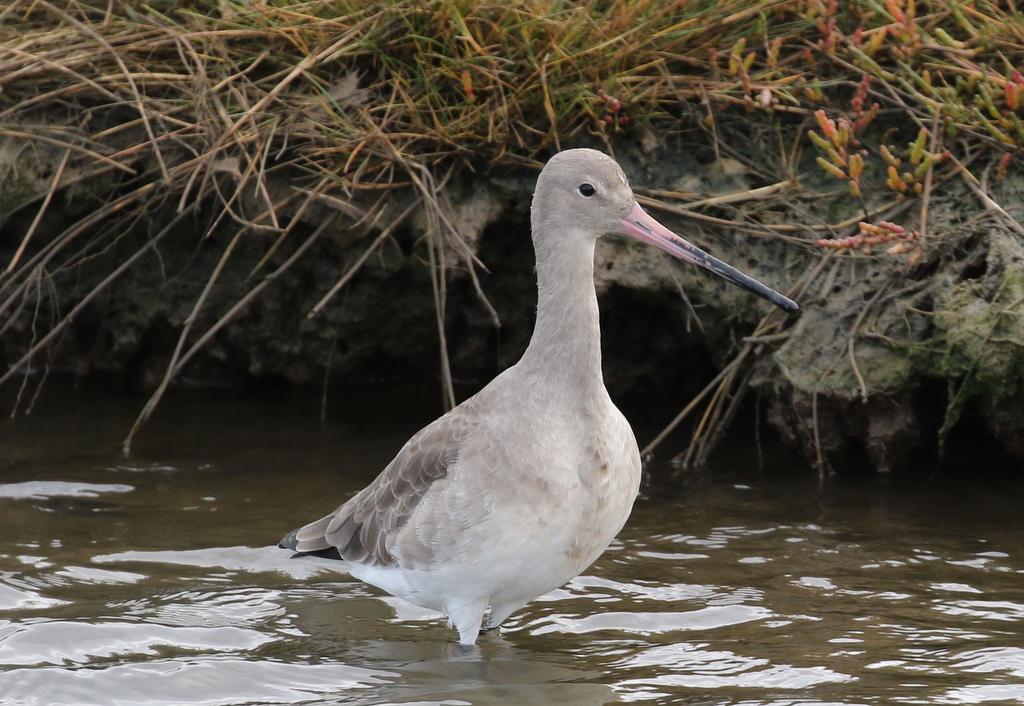 Black-tailed Godwit – showing well on the Tidal Pools
Black-tailed Godwit – showing well on the Tidal Pools
Further over, we could see a couple of small flocks of Eurasian Oystercatchers out on the saltmarsh and one of the spits which juts out into the water. A closer look through the scope revealed several Grey Plover roosting on the spit too, but most of the birds were hiding on the other side of the spit, in the lee of the wind. A flock of Ruddy Turnstone flew in and landed down in the saltmarsh with the Oystercatchers.
We continued on to the beach and stopped to scan the sea from the other side of the dunes, out of the wind. Our attention was drawn to a Great Crested Grebe hauled out on the sand on the edge of the water. It didn’t look particularly well. There were several more Great Crested Grebes out on the sea and a careful scan revealed a single Red-throated Diver though it was a little too far out to see easily in the swell and we lost it when it dived. Two Common Scoter close inshore were much easier to see.
 Common Scoter – these two were swimming just offshore
Common Scoter – these two were swimming just offshore
There were not many birds moving offshore today, though we did manage to pick up a handful of Brent Goose flying in for the winter and a little party of three Shelducks, probably returning after going over to the continent to moult out at the Waddensee.
The tide was already coming in fast and the mussel beds were covered. A large flock of Oystercatchers and Bar-tailed Godwits were roosting on the sand towards Brancaster, but as the tide continued to rise they took off and flew in over the beach and off towards the reserve. There were also several silvery grey and white Sanderling running around on the beach like clockwork toys.
It was already midday now, so we decided to start walking back slowly for lunch. We stopped again at the Tidal Pools where more waders had gathered to roost. Through the scope, we had a good look at a mixed group of Black-tailed and Bar-tailed Godwits and Grey Plovers. A single (not so Red) Knot appeared from behind them and started to bathe in the shallow water. A smart Redshank close to the path looked particularly striking with the sun highlighting its red legs and red-based bill.
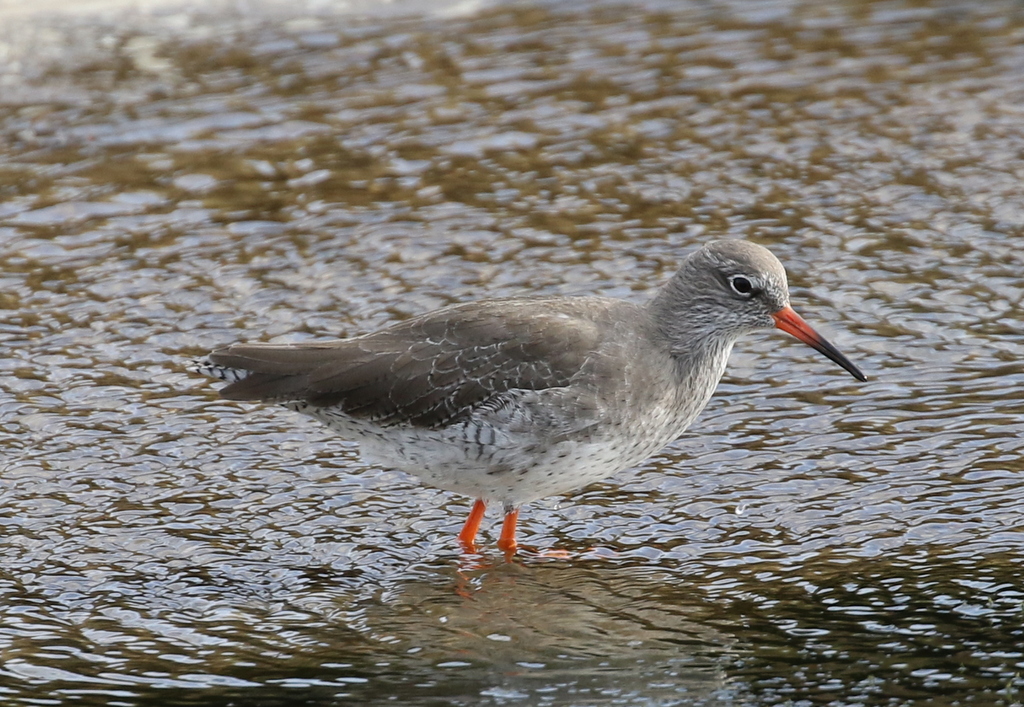 Redshank – its red legs and bill base catching the sun
Redshank – its red legs and bill base catching the sun
We stopped briefly at the Freshmarsh to see if anything new had arrived in our absence. A few more Golden Plover had flown in and gone to sleep on the islands. There had been a Dotterel here with them briefly yesterday, though there were also a lot more Golden Plover then, and there was no sign of it at all today.
When we got back to the trees, we took a diversion around Meadow Trail. There had been a Yellow-browed Warbler here earlier, but it was always going to be difficult to see today given the wind. At first, all we could find were a few tits and a single Chiffchaff. There were several Common Darter dragonflies basking in the sunshine out of the wind on the boardwalk which we flushed as we walked along.
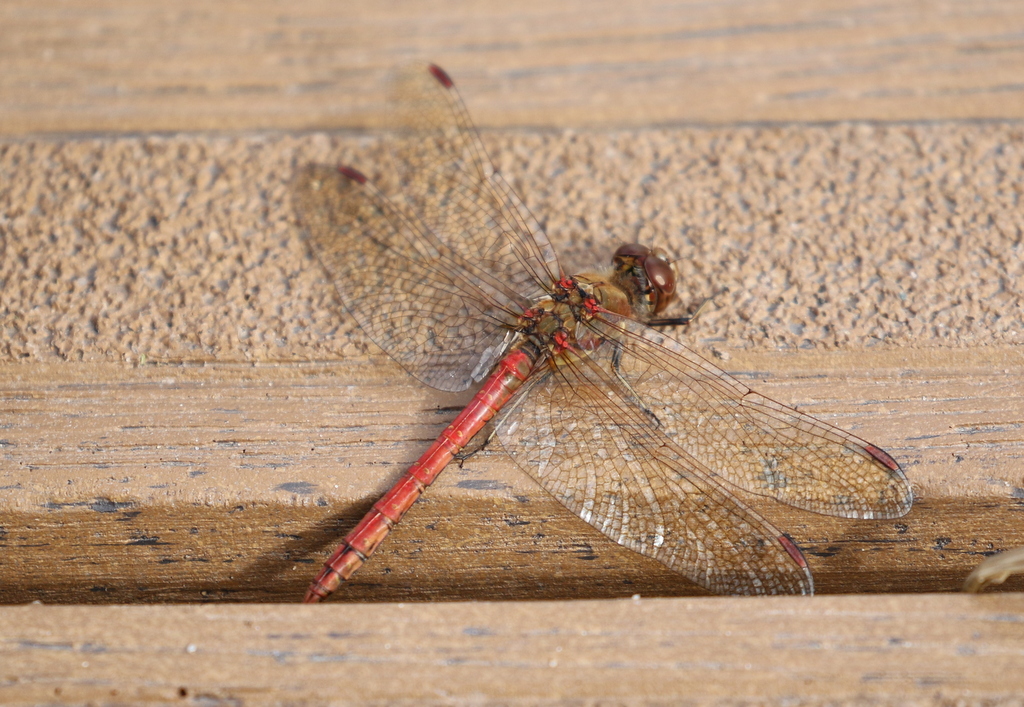 Common Darter – basking in the sunshine on the boardwalk
Common Darter – basking in the sunshine on the boardwalk
Then as we got round to the dragonfly pool, we heard the Yellow-browed Warbler calling from the sallows. Unfortunately, it had chosen the windy side of the boardwalk, and it was deep in the bushes – there seemed little chance it would come out this side. We had a quick look along Fen Trail, in case it worked its way through that way, but there was no sign. A flock of Long-tailed Tits had just gone across the path and possibly it was following behind them.
As we were eating lunch in the picnic area, we heard the Yellow-browed Warbler calling again, from deep in the sallows between where we were sitting and Fen Trail. We could hear Long-tailed Tits calling too, and we were hopeful initially they might be working their way through the trees towards us, but instead they disappeared off in the other direction. A Sparrowhawk flew over and several large skeins of Pink-footed Geese headed off east.
While we were getting ready to move on again, we were informed that several Bramblings had been showing around the feeders at the Visitor Centre. We stopped by the first set of feeders, where they had been on the ground, and waited a while. All we could see were Chaffinches feeding here. It was only when we went round to the feeders the other side that we discovered they had moved round there. We were treated to great views of at least two female Bramblings and two very smart males. There were also a few Siskins in the tops of the alders.
 Brambling – a smart male around the feeders behind the Visitor Centre
Brambling – a smart male around the feeders behind the Visitor Centre
After enjoying the Bramblings, we set off out along Fen Trail again. There was no sign of the Yellow-browed Warbler this time. A Kingfisher called from the dragonfly pool, but we didn’t see it. We carried on round to Patsy’s Reedbed, where there were fewer birds today. A smattering of ducks included just one Tufted Duck. A couple of Common Snipe were feeding along the bank at the front. As we continued out along East Trail, we flushed a couple of Song Thrushes from the hedge ahead of us. A tight flock of about thirty Siskin flew past us and headed off west.
We stopped at the end of Autumn Trail to scan the back of the freshmarsh. It didn’t take long to find three Spotted Redshanks, asleep by the fence at the back of the Avocet Island. We thought the corner of the scrape round the back here might have been more sheltered from the wind, but it was whistling through here too. It seemed an unlikely day for good views Bearded Tits, given the wind, but one male did fly in and land very close to us. Unfortunately it was too quick for everyone to get onto, shuffling up into the top of the reeds, which were swaying around in the breeze, before flying off over the bank.
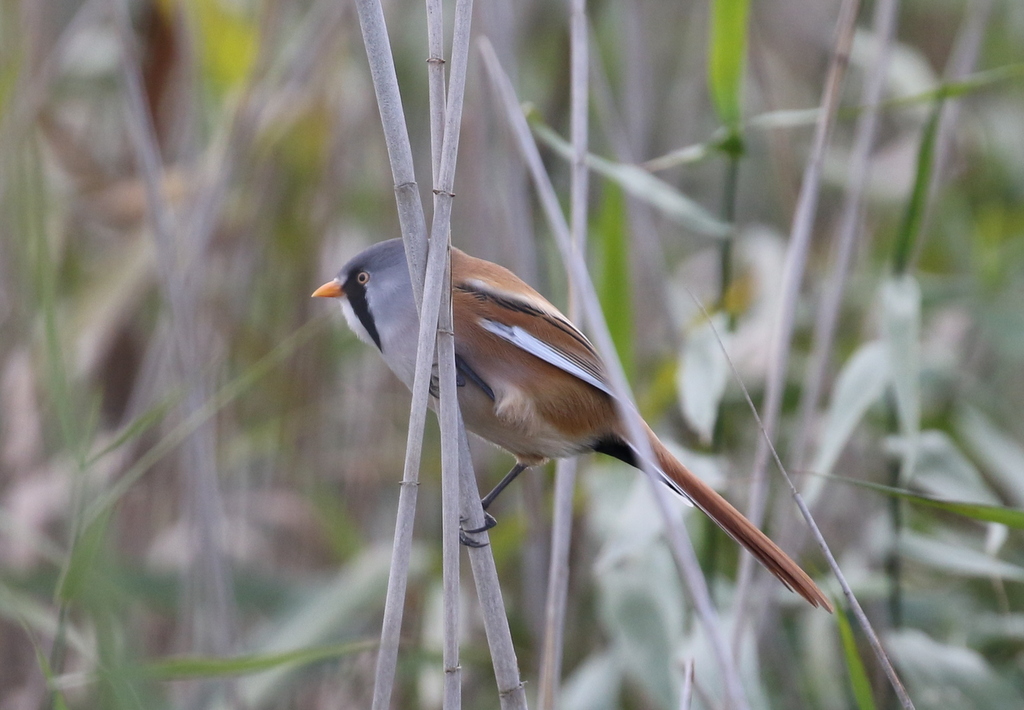 Bearded Tit – this male appeared only briefly in the tops of the reeds
Bearded Tit – this male appeared only briefly in the tops of the reeds
The afternoon was getting on now, so we made our way slowly back to the Visitor Centre. A Great Spotted Woodpecker flew out of Willow Wood and landed in one of the dead trees on the edge of the reedbed as we passed. We had obviously tired everyone out, because they immediately sank down onto the benches and picnic tables when we got back. We stopped just long enough to see a couple of Bramblings, back the other side of the centre now, then managed to get everyone moving again towards the car before they got too settled.
Rather than another walk, we decided to have a quick drive round via Choseley to see what we could see next. It was rather windy up on the ridge and nothing was very settled. There was a big flock of Goldfinch in the hedge and several coveys of Red-legged Partridges in the fields. We flushed a few Brown Hares as we drove past, which sprinted off across the fields – or across the road in front of us in one case.
At this point, we received a message to say there was a Bean Goose back along the coast, so as this was on our way back, we decided to head straight over there. We found somewhere to park and were directed to the bird, which was with a flock of Pink-footed Geese in a stubble field by the road. We could immediately see its day-glo orange legs and patterning on the bill, very different from the more muted pink on the Pink-footed Geese, so everybody had a quick first look at it through the scope.
There are two subspecies of Bean Goose we get here, treated by some now as separate species in their own right. Tundra Bean Goose occurs quite frequently in with the flocks of Pink-footed Geese in the winter. Taiga Bean Goose is considerably rarer here. There are two regular wintering sites for Taiga Bean Goose in the UK – on the Slamannan Plateau in Scotland and down at Cantley & Buckenham Marshes in the Norfolk Broads – and they are very unusual away from these sites. We were immediately struck by the large amount of orange on this birds bill. Then it stood up amongst the Pinkfeet and lifted its head – it was head and shoulders above the other geese – it had to be a Taiga Bean Goose!
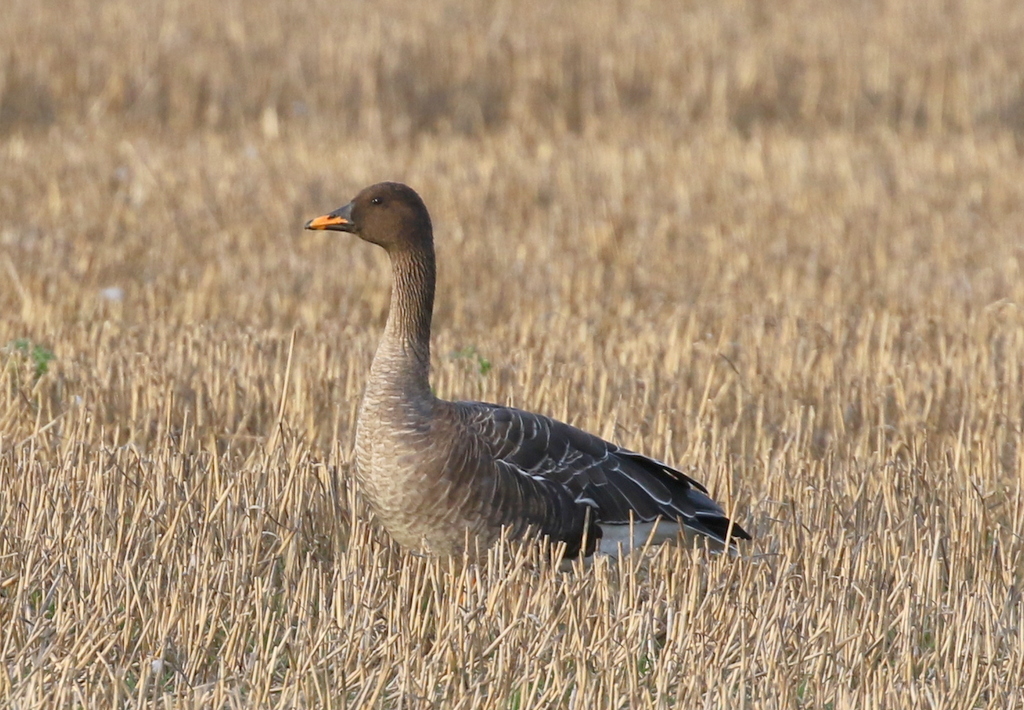 Taiga Bean Goose – a rare visitor here, away from a regular wintering site in the Broads
Taiga Bean Goose – a rare visitor here, away from a regular wintering site in the Broads
There was also a single Barnacle Goose down with the Pinkfeet, but it didn’t get as much attention as its more exotic – distant – relative. We do get wild Barnacle Geese here from time to time but there is also a feral population a short distance away at Holkham, and this bird had most likely just come from there.
The Taiga Bean Goose was getting a bit of hassle from the Pink-footed Geese, which would occasionally chase or peck out at it. It came out into the stubble in front of the other geese, stopped to preen, then took off on its own and flew up towards the road. It landed out of view in a dip in the ground, but by working our way along behind the hedge on the other side of the road, we managed to find a place from which we could see it.
 Taiga Bean Goose – not much smaller than the Greylags
Taiga Bean Goose – not much smaller than the Greylags
The Taiga Bean Goose was very close now, feeding this time with a small group of Greylag Geese. We could see it was a big goose, not much smaller than the Greylags, and with a long, thin, almost swan-like head and neck. The bill was long and thin and extensively marked with orange, very different from the stubbier bill of a Tundra Bean Goose. We had a great view and watched it for several minutes at close quarters. Eventually, the geese started to work their way back down the field, so we decided to leave them to it.
It was a very nice surprise to catch up with not only a Bean Goose, but a Taiga Bean Goose at that, on our way home. A great way to end another exciting day out.
















